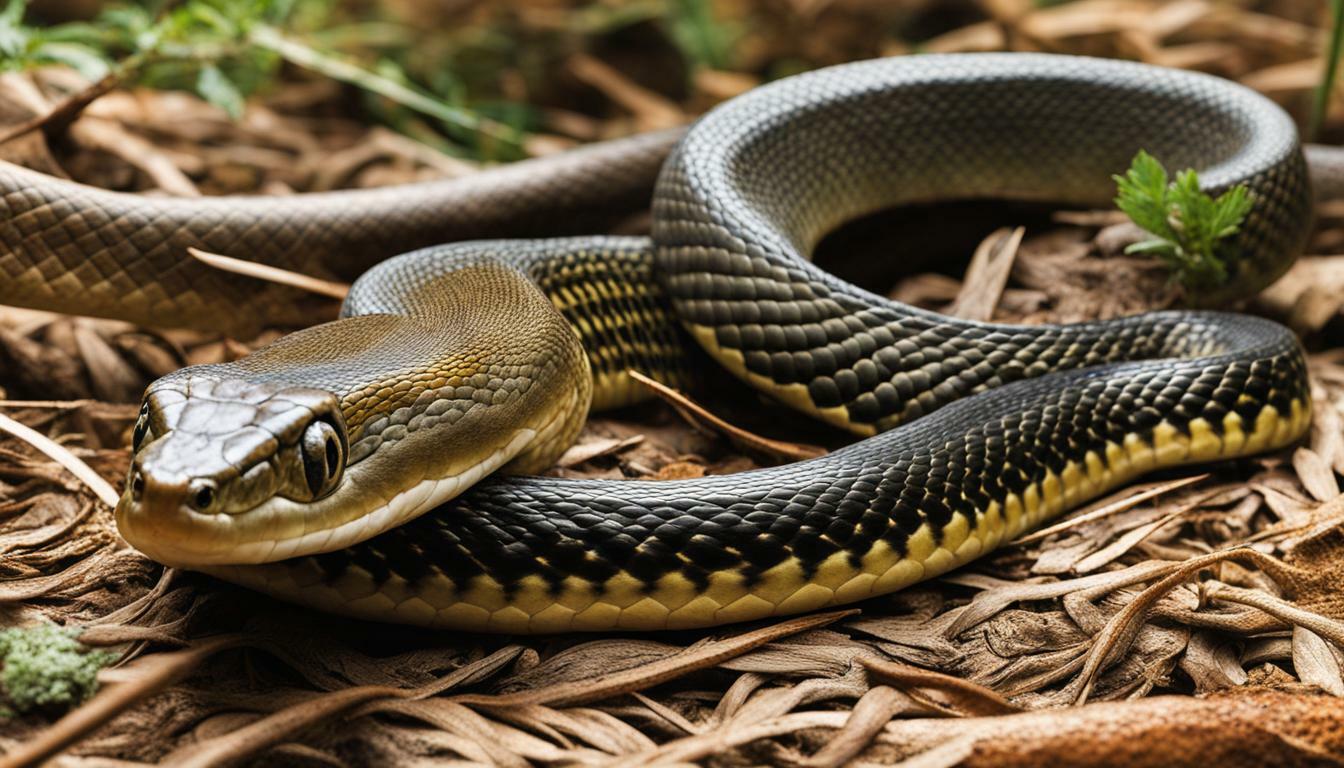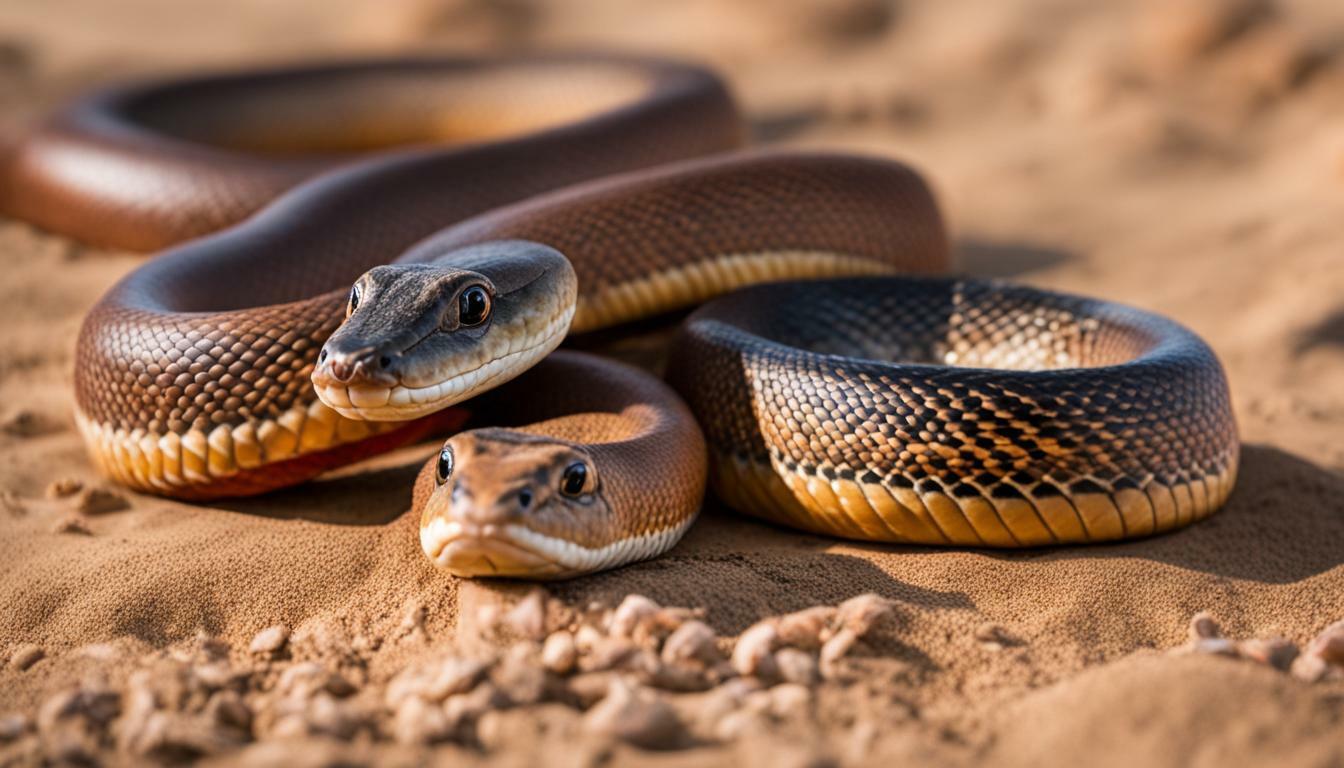Legless lizards and snakes are fascinating creatures with distinct characteristics that set them apart from each other. While both belong to the reptile family, they have evolved differently over time, resulting in some notable differences in their physical features and behaviors.
Key Takeaways:
- Legless lizards and snakes have both lost their limbs through evolution, but legless lizards lost them more recently.
- Legless lizards can blink and have tiny ear holes, while snakes have transparent eye membranes and lack external ears.
- Legless lizards primarily use their sides to move, while snakes can use both their sides and belly scales for locomotion.
- Legless lizards can detach their tails as a defense mechanism, whereas snakes cannot.
- Although legless lizards and snakes may have similar behavior and diets, there are noticeable differences that distinguish them.
Evolutionary Background
Legless lizards and snakes share a common evolutionary background, but their adaptations have led to distinct characteristics. These reptiles both belong to the order Squamata, which also includes other scaled reptiles like lizards and geckos. However, legless lizards and snakes have diverged over the course of millions of years, resulting in unique features that set them apart.
One key difference between legless lizards and snakes lies in the disappearance of their limbs. Legless lizards have lost their limbs through a gradual process of limb reduction, developing smaller and smaller limbs until they eventually disappeared. Snakes, on the other hand, lost their legs much earlier in their evolutionary history. This divergence in limb development has led to differences in locomotion and movement patterns between the two groups.
Another notable distinction is the presence of certain sensory adaptations. While both legless lizards and snakes lack external ears, legless lizards have tiny ear holes that allow them to detect sound vibrations. Snakes, on the other hand, rely on their specialized jawbones to detect vibrations in the ground. Additionally, legless lizards have movable eyelids and can blink, while snakes protect their eyes with transparent protective membranes.
Overall, the evolution of legless lizards and snakes showcases how adaptations to their environments have shaped their unique characteristics. While they may share a common ancestry, the specific adaptations and traits developed by each group have led to distinct features that allow them to thrive in their respective habitats.
Evolutionary Background Table
| Legless Lizards | Snakes |
|---|---|
| Gradual limb reduction | Early loss of limbs |
| Movable eyelids and blinking | Transparent protective membranes for eyes |
| Tiny ear holes for sound perception | Specialized jawbones for ground vibrations |
Physical Differences
While legless lizards and snakes may appear similar at first glance, their physical features reveal distinct differences between the two. Legless lizards, like their name suggests, have lost their limbs through evolution. Over millions of years, their legs and arms have gradually reduced in size until they disappeared completely. Snakes, on the other hand, lost their legs much longer ago in the evolutionary timeline.
One noticeable difference is in their eyes. Legless lizards have movable eyelids and can blink, just like other lizards. In contrast, snakes have transparent scales over their eyes, known as spectacles, which protect their eyes without the need for blinking. Another distinguishing feature is their ears. Legless lizards have tiny ear holes, while snakes lack external ears altogether. This difference in ear structure influences their ability to hear and perceive their environments.
When it comes to locomotion, legless lizards primarily use their sides to move. They undulate their bodies in a wave-like motion that propels them forward. In contrast, snakes can use both their sides and their belly scales for movement. This allows snakes to slither and glide across varying surfaces with ease.
Additionally, legless lizards have developed a unique defense mechanism. They can detach their tails in order to escape from predators. The detached tail wriggles and distracts the predator while the legless lizard makes its escape. This ability to self-amputate their tails is not present in snakes.
| Physical Features | Legless Lizards | Snakes |
|---|---|---|
| Limb Structure | Lost limbs through evolution | Lost limbs much earlier |
| Eyes | Movable eyelids | Transparent scales (spectacles) |
| Ears | Tiny ear holes | No external ears |
| Locomotion | Primarily use sides for movement | Use sides and belly scales for movement |
| Defense Mechanism | Can detach tail as a distraction | Cannot detach tail |
Locomotion and Movement
Legless lizards and snakes have adapted unique methods of locomotion that allow them to thrive in their respective habitats. While legless lizards primarily use their sides to move, snakes have the ability to use both their sides and belly scales. This distinction in locomotion gives them different modes of propulsion. Legless lizards move in a serpentine motion, pushing off the ground with their strong, muscular bodies and using their scales to grip and propel themselves forward. On the other hand, snakes utilize a combination of undulating their bodies and using their belly scales to push against the ground, allowing for smooth and efficient movement.
Furthermore, legless lizards can detach their tails as a defense mechanism. When threatened, they can break off their tails, leaving them behind to distract predators while they escape. This process, known as autotomy, is a unique adaptation that sets legless lizards apart from snakes. Unlike legless lizards, snakes are unable to detach their tails. Their tails serve important functions such as providing stabilization during movement and acting as a weapon for defense.
Both legless lizards and snakes have evolved to be incredibly agile and skilled climbers. Despite lacking limbs, they are adept at navigating various terrains, including tree branches and rocky surfaces. This is made possible through their muscular bodies, specialized scales, and strong grip. Their remarkable ability to move effortlessly in their environments showcases their adaptability and survival skills as reptiles.
| Legless Lizards | Snakes |
|---|---|
| Move primarily using their sides | Move using sides and belly scales |
| Can detach their tails as a defense mechanism | Cannot detach their tails |
| Use their strong bodies and scales to grip and propel themselves | Undulate their bodies and use belly scales for propulsion |
Sensory Abilities
Legless lizards and snakes have developed remarkable sensory abilities to survive and thrive in their specific habitats. These reptiles rely on their senses to find food, detect predators, and navigate their surroundings.
One key difference between legless lizards and snakes is their preferred habitats. Legless lizards are typically found in a variety of habitats, including forests, grasslands, and deserts. They have adapted to these diverse environments by developing sensory organs that help them detect prey. Legless lizards have specialized chemosensory systems, allowing them to detect the scents and chemical trails left by their prey. This enables them to locate and capture insects, spiders, and small vertebrates.
On the other hand, snakes are primarily found in terrestrial and aquatic habitats. They have evolved a unique sensory system called “thermoception,” which allows them to detect heat and locate warm-blooded prey. Snakes possess specialized heat-sensing pits called “pit organs” on the sides of their heads. These pits can detect even the slightest temperature differences, helping snakes locate and strike at their potential prey.
| Legless Lizards | Snakes |
|---|---|
| Have a developed chemosensory system | Have specialized heat-sensing pits |
| Habitat: forests, grasslands, deserts | Habitat: terrestrial and aquatic |
| Prey: insects, spiders, small vertebrates | Prey: warm-blooded animals |
In addition to their unique sensory adaptations, both legless lizards and snakes have highly developed eyesight. While snakes lack eyelids, they have a transparent scale called a spectacle that protects their eyes. Legless lizards, on the other hand, can blink their eyes, but they lack the spectacle found in snakes. This difference in eye protection highlights the distinct evolutionary paths these reptiles have taken.
Overall, the sensory abilities of legless lizards and snakes reflect their respective habitats and hunting strategies. While legless lizards rely on chemosensation to track down their prey in various environments, snakes use thermosensation to locate and capture warm-blooded animals. These adaptations demonstrate the remarkable diversity and adaptability of reptiles in different ecosystems.
Defense Mechanisms
Legless lizards and snakes have developed unique defense mechanisms to ensure their survival in the wild. These adaptations help them ward off predators and secure their place in their respective habitats.
One notable difference between legless lizards and snakes is their ability to detach their tails. Legless lizards, as a defense mechanism, can voluntarily shed their tails when threatened. This action not only distracts predators but also allows the lizards to escape unharmed. The detached tail continues to wriggle and twitch, creating a diversion that buys the lizard precious time to flee.
Snakes, on the other hand, cannot detach their tails. Instead, they rely on other defense strategies such as venomous bites or constriction. Venomous snakes inject potent toxins into their prey or predators, which immobilize or even kill their targets. Constrictor snakes, like the boa constrictor, use their powerful bodies to wrap around their prey and squeeze until it suffocates, enabling them to feed on animals larger than themselves.
Additionally, both legless lizards and snakes have developed camouflage techniques to blend into their surroundings. This allows them to remain unnoticed by predators or potential prey. Legless lizards often have intricate patterns and colors that resemble their habitats, such as sandy or rocky surfaces. Snakes, too, have evolved a range of colors and patterns that enable them to blend into different environments, such as grasslands, forests, or deserts.
Conclusion
Legless lizards and snakes are both remarkable creatures, but their differences in appearance, behavior, and adaptations make each species truly unique.
Legless lizards, through millions of years of evolution, have lost their limbs, developing smaller and smaller limbs until they disappeared completely. In contrast, snakes lost their legs much longer ago. Another distinction lies in their eyes – legless lizards can blink, while snakes have transparent membranes that protect their eyes.
Additionally, legless lizards possess tiny ear holes, allowing them to pick up on sound vibrations, while snakes lack external ears. As for movement, legless lizards primarily use their sides to move, while snakes can use their sides and belly scales for locomotion.
Defensive mechanisms also differ between the two species. Legless lizards have the ability to detach their tails, leaving them behind to distract predators, while snakes cannot detach their tails. Moreover, while legless lizards and snakes share similar behavior and diets, there are several noticeable differences that distinguish them in terms of their habitats and feeding strategies.
Overall, understanding the distinctions between legless lizards and snakes provides a comprehensive insight into the fascinating world of reptiles.
FAQ
What are legless lizards?
Legless lizards are a type of reptile that have evolved over millions of years to lose their legs. They have developed smaller and smaller limbs until their legs and arms disappeared.
How do legless lizards differ from snakes?
Legless lizards and snakes have some similarities, but there are noticeable differences between them. Legless lizards can blink and have tiny ear holes, while snakes have transparent eye protection and lack external ears. Legless lizards primarily use their sides to move, while snakes can use both their sides and belly scales. Additionally, legless lizards can detach their tails as a defense mechanism, while snakes cannot.
What do legless lizards and snakes have in common?
Legless lizards and snakes share similar behavior and diets. They both belong to the reptile family and are carnivorous, feeding on small animals such as insects and rodents.
Where can legless lizards and snakes be found?
Legless lizards and snakes have different habitats, but they can be found in various regions around the world. Legless lizards are found in North America, Europe, and Asia, while snakes have a broader distribution, inhabiting almost every continent except Antarctica.
Are legless lizards and snakes dangerous to humans?
While both legless lizards and snakes have the potential to bite if threatened, most species are not venomous and pose little danger to humans. It is always important to exercise caution and respect their natural habitats.
Can legless lizards regrow their legs?
No, legless lizards cannot regrow their legs once they have been lost through evolution. Their limbs have completely disappeared, and they have adapted to a legless lifestyle.
Source Links
- https://animals.howstuffworks.com/snakes/legless-lizard-vs-snake.htm
- https://www.osc.org/how-to-identify-a-legless-lizard-versus-a-snake/
- https://www.washingtonpost.com/lifestyle/kidspost/these-lizards-lost-their-legs-but-dont-call-them-snakes/2020/12/18/0b5661ba-3650-11eb-8d38-6aea1adb3839_story.html
 Skip to main content
Skip to main content


